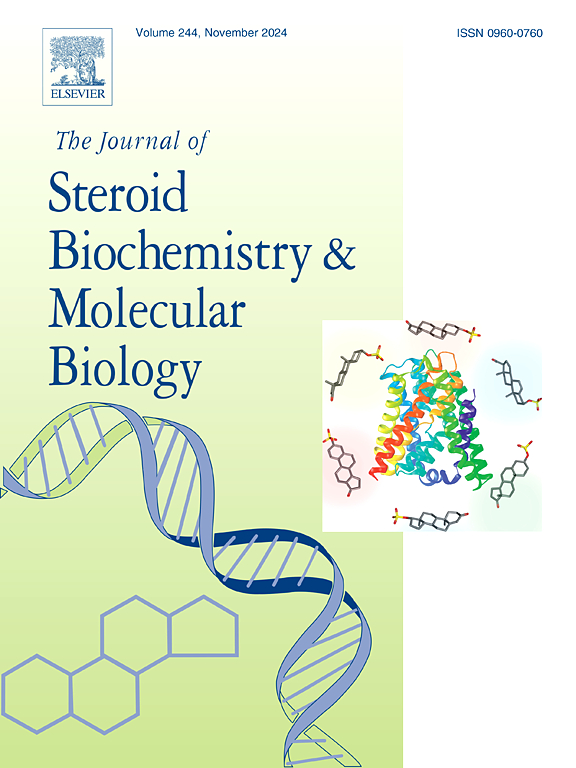18-40岁女性干血斑中4种循环性类固醇参考范围的评价
IF 2.5
2区 生物学
Q3 BIOCHEMISTRY & MOLECULAR BIOLOGY
Journal of Steroid Biochemistry and Molecular Biology
Pub Date : 2025-06-03
DOI:10.1016/j.jsbmb.2025.106796
引用次数: 0
摘要
毛细管干血斑收集提供了一个极好的侵入性较小的替代血清或血浆收集静脉切开术。本研究旨在建立健康绝经前妇女毛细血管全血样本中4种性类固醇的参考范围,作为检测性发育障碍的一种筛查方法。使用这种方法,我们根据年龄、体重指数、月经周期和激素避孕药的使用来评估变化。这项以社区为基础的横断面研究包括120名年龄在18-40岁、未怀孕或未哺乳的健康绝经前妇女。采用液相色谱-串联质谱法(LCMS)测定干滤纸血斑的全血睾酮(T)、雄烯二酮(A4)、17α羟孕酮(17OHP)和孕酮(P4)。T的中位数(95 %置信限)为0.75 (0.28,2.20)nmol/L, A4为2.69 (1.02,6.03)nmol/L, 17OHP为1.62 (0.32,8.52)nmol/L, P4为0.65 (0.18,41.0)nmol/L。年龄间隔5年与A4的逐渐降低有关,但与其他类固醇无关。17OHP和P4的月经变化明显,黄体期增加,A4有一个小的中期周期高峰,但没有其他一致的变化。服用全身性激素避孕药(联合口服避孕药或炔诺孕酮植入)的参与者的所有性类固醇浓度都显著降低。性类固醇浓度与体重指数没有显著的变化。这些数据为健康青年绝经前妇女干血斑LCMS测定全血T、A4、17OHP和P4提供了参考范围。根据年龄、激素避孕药的使用和月经周期阶段,有明显的小而显著的变化。本文章由计算机程序翻译,如有差异,请以英文原文为准。
Evaluation of reference ranges of four circulating sex steroids from dried blood spots in women aged 18-40 years
Capillary dried blood spot collection offers an excellent less invasive alternative to serum or plasma collection by venesection. This study aimed to generate reference ranges for four sex steroids in capillary whole blood samples collected from healthy premenopausal women as dried blood spots as a screening method to detect disorders of sex development. Using this method we evaluated variations according to age, body mass index, menstrual cycle, and hormonal contraceptive use. This cross-sectional, community-based study included 120 healthy premenopausal women aged 18-40 years, not pregnant or breastfeeding. Whole blood testosterone (T), androstenedione (A4), 17α hydroxyprogesterone (17OHP), and progesterone (P4) were measured by liquid chromatography-tandem mass spectrometry (LCMS) from dried filter paper blood spots. The median (95 % confidence limits) for T were 0.75 (0.28, 2.20) nmol/L, A4 2.69 (1.02, 6.03) nmol/L, 17OHP 1.62 (0.32, 8.52) nmol/L and P4 0.65 (0.18, 41.0) nmol/L. Age by 5-year interval was associated with a progressive reduction in A4 but not for other steroids. Menstrual variation was evident for 17OHP and P4 with increases in luteal phase with a small mid-cycle peak for A4 but no other consistent changes. All sex steroid concentrations were significantly lower in participants taking a systemic hormonal contraceptive (combined oral contraceptive or etonogestrel implant). None of the sex steroid concentrations varied significantly with body mass index. These data provide reference ranges for whole blood T, A4, 17OHP and P4 measured by LCMS from dried blood spots from healthy young adult premenopausal women. Small but significant variations were evident according to age, hormonal contraceptive use and menstrual cycle phase.
求助全文
通过发布文献求助,成功后即可免费获取论文全文。
去求助
来源期刊
CiteScore
8.60
自引率
2.40%
发文量
113
审稿时长
46 days
期刊介绍:
The Journal of Steroid Biochemistry and Molecular Biology is devoted to new experimental and theoretical developments in areas related to steroids including vitamin D, lipids and their metabolomics. The Journal publishes a variety of contributions, including original articles, general and focused reviews, and rapid communications (brief articles of particular interest and clear novelty). Selected cutting-edge topics will be addressed in Special Issues managed by Guest Editors. Special Issues will contain both commissioned reviews and original research papers to provide comprehensive coverage of specific topics, and all submissions will undergo rigorous peer-review prior to publication.

 求助内容:
求助内容: 应助结果提醒方式:
应助结果提醒方式:


